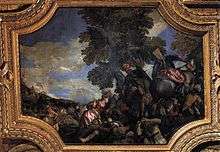Antonio Loredan
Antonio Loredan (Latin: Antonius Lauretanus) (1420 – August 1482)[1] was a member of Venetian noble family Loredan, captain of Venetian-held Scutari (Shkodër in modern Albania) and governor in Split, Albania Veneta, and the Morea.
Antonio Loredan | |
|---|---|
| Born | 1420 |
| Died | August 1482 |
| Nationality | Venetian |
| Occupation | military officer and governor |
| Known for | successful defense of Scutari in 1474 |

Family
Antonio Loredan was born into the Loredan noble Venetian family. His wife was Orsa (Orsola) Pisani,[2] with whom he had three sons: Giovanni, Marco and Jacopo.[3]
Morea and Dalmatia
In 1466 Loredan was governor in the Morea.[4] In the period 1467—69 he was a governor of Split in Venetian Dalmatia.[5]
Albania Veneta
Loredan was appointed as captain of Scutari and governor of Albania Veneta on 12 July 1473.[6]
He was one of Venetian military commanders during the Siege of Shkodra (1474).[7] According to some sources, when Scutari garrison complained for lack of food and water, Loredan told them "If you are hungry, here is my flesh; if you are thirsty, I give you my blood."[8]
Because of the successful defense of the city he was considered a war hero.[9] Venetian government awarded Loredan with title of "Knight of San Marco".[10] To celebrate this victory Venetians decided on 4 September 1474 to construct a hospital.[11]
Cyprus and Venice
After successful defense of Scutari, Loredan was ordered by the Venetian government to seize Cyprus and garrison its castles[12] after destroying Ottoman forts on Bojana first. The purpose of this move was to prevent the Republic of Genoa to use unstable situation at Cyprus and capture it first.[13]
In 1478 Loredan was elected as a Procurator of San Marco.[14] He died of marsh fever in 1482, during the War of Ferrara.[15]
In literature and the arts
Loredan is mentioned in many works of literature, such as those authored by Stjepan Mitrov Ljubiša[16] and Marin Barleti.[17]
References
- Lothar W. Pawliczak (2011). Was man so alles nicht von Venedig weiß: alte Geschichten - neue Mythen. BoD – Books on Demand. p. 318. ISBN 978-3-8448-0049-4.
- Stefania Mason Rinaldi; Vittore Carpaccio (1 November 2000). Carpaccio: the major pictorical cycles. Skira. p. 33. ISBN 978-88-8118-737-9.
Orsa Pisani, wife of Antonio Loredan
- Gallerie dell'Accademia di Venezia; Italy. Soprintendenza ai beni artistici e storici di Venezia (1998). Accademia Galleries in Venice. Electa. p. 213. ISBN 978-88-435-6667-9.
The veiled woman kneeling at the foot of the catafalque could be based on Orsa (Orsola), the wife of Antonio Loredan, the hero of Scutari.
- M. E. Mallett; J. R. Hale (2006). The Military Organisation of a Renaissance State: Venice C. 1400 To 1617. Cambridge University Press. p. 175. ISBN 978-0-521-03247-6.
Antonio Loredan was proveditor in the Morea in 1466...
- Mogućnosti. Matica hrvatska, Split. 1991. p. 430.
...prema imenu gradskog kneza i kapetana Antuna Loredana koji je upravljao u Splitu od 1467. do kraja 1469. godine.
- Théoharis Stavrides (2001). "The" Sultan of Vezirs: The Life and Times of the Ottoman Grand Vezir Mahmud Pasha Angelović (1453 - 1474). Brill. p. 225. ISBN 978-90-04-12106-5.
On 12 July 1473 Antonio Loredan was appointed new captain of Scutari and Proweditore of Albania
- Hugh Honour (1997). The Companion Guide to Venice. Companion Guides. p. 53. ISBN 978-1-900639-24-8.
- C. Marshall Smith (1927). The Seven Ages of Venice: A Romantic Rendering of Venetian History. Blackie & son, limited. p. 134.
If you are hungry, here is my flesh; if you are thirsty, I give you my blood.
- Seth Parry (2008). Fifty Years of Failed Plans: Venice, Humanism, and the Turks (1453--1503). ProQuest. p. 476. ISBN 978-0-549-80891-6.
The victory at Scutari also made Antonio Loredan a war hero.
- Italian history & culture. Cadmo. 1997. p. 136.
Antonio Loredan, the heroic defender of Scutari in 1474, whom the government named knight of San Marco for his military merits.
- Manfredo Tafuri (2006). Interpreting the Renaissance: Princes, Cities, Architects. Yale University Press. p. 87. ISBN 978-0-300-11158-3.
On September 4, 1474, it was decided that a hospital should be constructed to celebrate Antonio Loredan's heroic defense of Scutari.
- Horatio Forbes Brown (1973). Studies in the History of Venice. B. Franklin. p. 134. ISBN 978-0-8337-4007-6. Retrieved 5 December 2013.
The Venetian government ordered their admiral, Antonio Loredan, the hero of Scutari, to garrison the forts on the island,' and to arrest and send to Venice Maria Patras, the mother of James, along with his three bastard children.
- Zarij M. Bešić (1970). Istorija Crne Gore: Od najstarijih vremena do kraja XII vijeka. Pedakt︠s︡ija za istoriju t︠s︡rne gore. p. 315.
- Giordana Mariani Canova (1969). La Miniatura veneta del Rinascimento: 1450-1500. dAlfieri. p. 157. Retrieved 6 December 2013.
Poiché Antonio Loredan fu procuratore di S. Marco nel 1478
- John Rigby Hale; David Chambers; Cecil H. Clough; Michael Mallett (1993). War, Culture and Society in Renaissance Venice: Essays in Honour of John Hale. Continuum. p. 67. ISBN 978-1-85285-090-6. Retrieved 6 December 2013.
Both Antonio Loredan and Damiano Moro were dead from marsh fever before the end of the campaign of 1482.
- Stjepan Mitrov Ljubiša (2005). Kanjoš Macedonović. Politika. pp. 72, 78, 91.
- Marin Barleti (2012). The Siege of Shkodra: Albania's Courageous Stand Against Ottoman Conquest, 1478. David Hosaflook. p. 175. ISBN 978-99956-87-77-9.
External links
- George Merula The Siege of Shkodra (1474) - published on the website of Robert Elsie